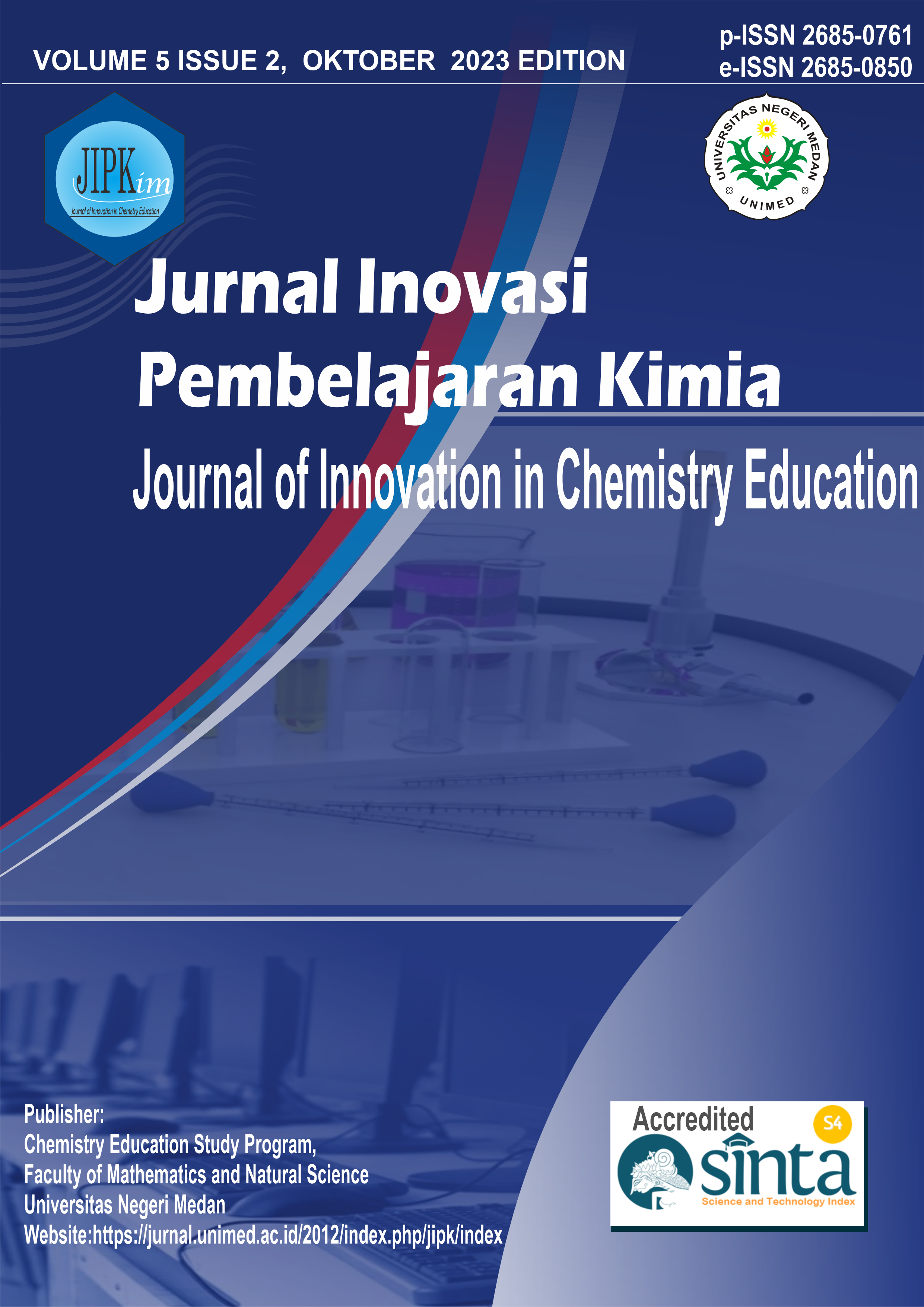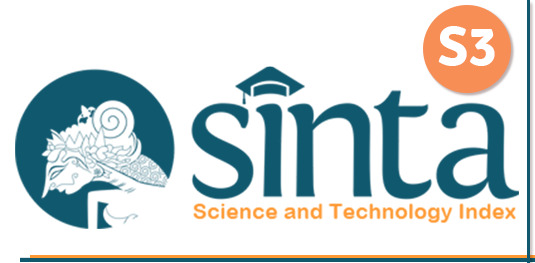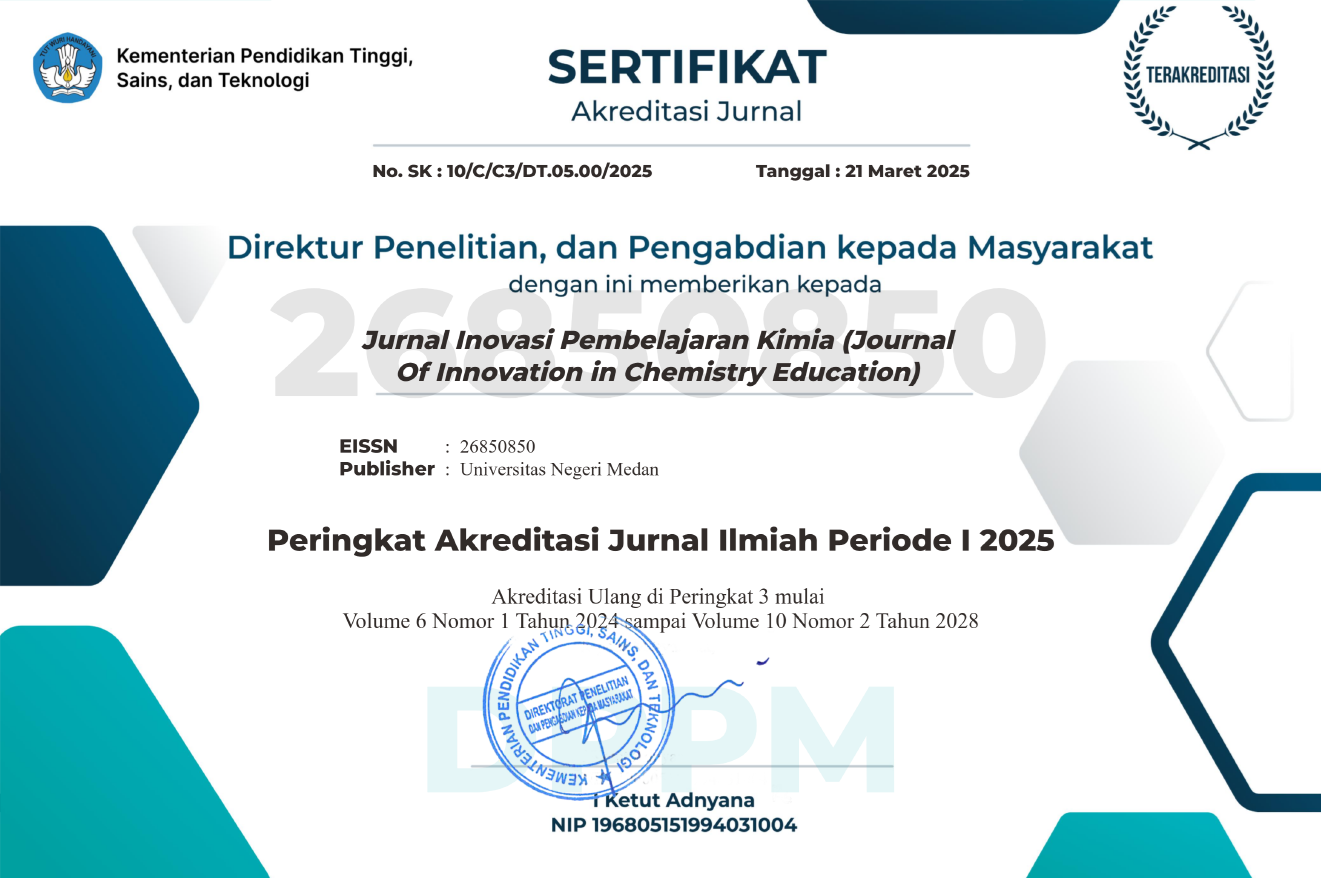Analysis of Students' Learning Outcomes and Scientific Literacy Activities Using Guided Inquiry and Discovery Learning Models
DOI:
https://doi.org/10.24114/jipk.v5i2.55908Keywords:
Learning Outcomes, Scientific Literacy Activities, Discovery Learning, Guided Inquiry, Reaction RateAbstract
This research aims to find out whether the Guided Inquiry learning model is better than Discovery Learning in improving scientific literacy activities and student learning outcomes on reaction rate material. The research method used is quasi experimental. The sample from this research consisted of two classes, namely experimental class I which was taught using the guided inquiry learning model, totaling 29 students and experimental class II, which was taught using the Discovery Learning model, totaling 27 students. The results of data analysis show that the average learning outcomes of students using Guided Inquiry (80.69) are higher than the average learning outcomes of students taught using the Discovery Learning model (74.63) and the average scientific literacy activities of students using Guided Inquiry (79.15 ) higher than the average using the Discovery Learning model (73.72). Hypothesis results using the right-hand t-test and α = 0.05 obtained tcount > ttable (2.34 > 1.675) for students' scientific literacy activities and tcount > ttable (2.49 > 1.675) for student learning outcomes so that in this study the null hypothesis (Ho) is rejected and the alternative hypothesis (H₂) is accepted. Thus, it was found that the Guided Inquiry learning model was better than Discovery Learning in improving scientific literacy activities and student learning outcomes on reaction rate material.References
Agustina, Auliah, A., & Hardin. (2023). Development of Handout Android-Based Application on Buffer Solution using Discovery Learning Model. Jurnal Inovasi Pembelajaran Kimia, 17“27. https://jurnal.unimed.ac.id/2012/index.php/jipk/article/view/44516%0Ahttps://jurnal.unimed.ac.id/2012/index.php/jipk/article/download/44516/20839
Ain, Q., & Mitarlis, M. (2020). Development of Guided Inquiry-Oriented Student Worksheets to Increase Scientific Literacy on Factors That Influence Reaction Rates. UNESA Journal of Chemical Education, 9(3), 397“406. https://doi.org/10.26740/ujced.v9n3.p397-406
Anggraeni, L., & Hidayah, R. (2019). Validity of Student Activity Sheet Practicum Chemistry Oriented By Guided Inquiry To Train Science Process Skill. Unesa Journal of Chemical Education, 8(1), 82“87.
Cholifah, S. N., & Novita, D. (2022). Development of Guided Inquiry-Liveworksheet E-LKPD to Increase Scientific Literacy in Reaction Rate Factor Sub-material. Chemistry Education Practice, 5(1), 23“34. https://doi.org/10.29303/cep.v5i1.3280
Erlidawati, E., & Habibati, H. (2020). Application of the Discovery Learning Model to Improve Student Activities and Learning Outcomes on Thermochemical Material. Jurnal Pendidikan Sains Indonesia, 8(1), 92“104. https://doi.org/10.24815/jpsi.v8i1.16099
Fatmawati, I. N., & Utari, S. (2015). Application of Levels of Inquiry to Increase the Scientific Literacy of Middle School Students with Waste Theme and Efforts to Handle It. Edusains, 7(2), 152“159.
Ginting, F. A., Syahputra, R. A., Purba, J., Sutiani, A., & Dibyantini, R. E. (2022). Development of an Integrated Science Discovery Learning Based Module on Chemical Equilibrium Material. Jurnal Inovasi Pembelajaran Kimia, 1(4), 296“305. https://doi.org/10.55904/educenter.v1i4.86
Imansari, M., Sudarmin, & Woro Sumarni. (2018). Analysis of Students' Chemical Literacy Through Guided Inquiry Learning Containing Ethnoscience. Jurnal Inovasi Pendidikan Kimia, 12(2), 2201“2211.
Juniar, A., Mistryanto, P., Sapla, N., & Dewi. (2019). The Effect of Implementing the Guided Inquiry Model on Science Process Skills and Student Learning Outcomes. Jurnal Inovasi Pembelajaran Kimia, 1(1), 23. https://doi.org/10.24114/jipk.v1i1.12534
Komariah, U. H., Arifuddin, M., & Misbah. (2017). Improving Science Process Skills Through the Guided Inquiry Discovery Learning Model on the Subject of Static Fluids in Class XI Science 4 at SMAN 11 Banjarmasin. Berkala Ilmiah Pendidikan Fisika, 5(3), 309. https://doi.org/10.20527/bipf.v5i3.3876
Malau, R., & Juniar, A. (2020). The Influence of the Guided Inquiry Learning Model on Student Skills and Learning Outcomes in Acid-Base Material. Jurnal Inovasi Pembelajaran Kimia, 2(1), 41. https://doi.org/10.24114/jipk.v2i1.17850
Marpaung, A. R., & Sutiani, A. (2020). Implementation of the Problem Based Learning Model with a Scientific Approach to Student Reaction Rate Learning Outcomes. Jurnal Inovasi Pembelajaran Kimia, 2(1), 11. https://doi.org/10.24114/jipk.v2i1.16736
Oktaviana, D., Widodo, A. T., & Kasmui. (2020). Effectiveness of the Guided Inquiry Learning Model on High School Students' Activities and Learning Outcomes on Hydrolysis Material. Journal of Chemistry In Education, 9(1), 133“139. http://journal.unnes.ac.id/sju/index.php/chemined
Pamularsih, B. (2019). Improving Chemistry Learning Outcomes Using the Discovery Learning Learning Model on Thermochemistry Subjects. Prosiding Seminar Nasional, 1(1), 70“77.
Panggabean, F. T. M., Silitonga, P. M., Purba, J., Jasmidi, & Purba, ica A. (2023). Analysis Student Motivation and Learning Outcomes by Apllying Problem Based Learning and Discovery Learning Models. Jurnal Inovasi Pembelajaran Kimia. https://jurnal.unimed.ac.id/2012/index.php/jipk/article/view/42419%0Ahttps://jurnal.unimed.ac.id/2012/index.php/jipk/article/viewFile/42419/20831
Permatasari, I., Sesunan, F., & Wahyudi, I. (2018). Comparison of Student Learning Outcomes Between Guided Inquiry and Discovery Learning Models. Journal of Komodo Science Education, 01(01), 53“65. http:ejournal.stkipsantupaulus.ac.id/index.php/jkse
Pratama, G. W., & dkk. (2015). Effectiveness of Guided Inquiry on Acid-Base-Salt Material. | 769. 769“781.
Rahmi, A., Fitriani, H., & Mauliani, N. (2020). Comparative Study of Guided Inquiry and Discovery Learning on Students™ Cognitive. Jurnal Inovasi Pembelajaran Kimia, 7“11.
Sunandari, H. (2015). Models of Learning and Acquisition of Second/Foreign Languages. Pujangga, 1(2), 106“117.
Utami, H. H., Sulfikar, & Anwar, M. (2017). The Influence of Chemsketch in Writing Chemical Structures in the Recitation Method on Student Learning Outcomes. Jurnal Penelitian Pendidikan INSANI, 20, 96“100.
Yunsyahana, F., Auliah, A., & Djangi, M. J. (2022). The Effectiveness of the Discovery Learning Learning Model on the Learning Outcomes of Class X MAN Bantaeng Students. Jurnal Inovasi Pembelajaran Kimia, 4(1), 92. https://doi.org/10.24114/jipk.v4i1.33436













